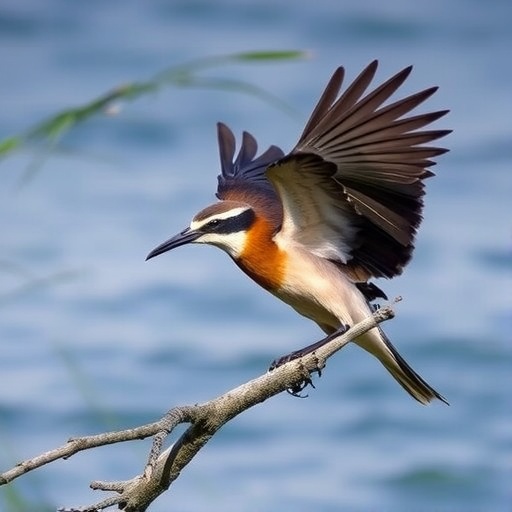
A remarkable discovery from the remote Rēkohu Chatham Islands has shed new light on how isolated environments can profoundly shape the evolutionary trajectory of animal species. The unveiling of a previously unknown extinct species of shelduck offers a striking case study in evolutionary biology, demonstrating how geographic isolation and environmental pressures drive morphological and genetic adaptation over relatively short geological timescales.
Led by researchers from the University of Otago’s Otago Palaeogenetics Laboratory, the study meticulously reconstructs the life and extinction of the Rēkohu shelduck (Tadorna rekohu), a bird lineage that diverged from its closest relative—the pūtangitangi paradise shelduck native to mainland Aotearoa New Zealand—approximately 390,000 years ago. Despite appearing brief on a geological clock, this timespan has been sufficient to induce significant evolutionary modifications, primarily in wing and leg morphology that suggest progressive flightlessness.
Through an integrative approach combining ancient DNA analysis with detailed morphometric measurements of fossilized bones, the research team established the phylogenetic position of this insular shelduck species. The adaptive changes observed, such as reduced wing length accompanied by robust, elongated legs, align with evolutionary patterns frequently documented in island taxa, where flight adaptations are lost or diminished due to relaxed predation pressures and energetically costly flight behaviors becoming disadvantageous.
.adsslot_8Yzp5TRl0F{width:728px !important;height:90px !important;}
@media(max-width:1199px){ .adsslot_8Yzp5TRl0F{width:468px !important;height:60px !important;}
}
@media(max-width:767px){ .adsslot_8Yzp5TRl0F{width:320px !important;height:50px !important;}
}
ADVERTISEMENT
Associate Professor Nic Rawlence, Director of the Otago Palaeogenetics Laboratory and co-lead investigator, elaborates on these findings: “In the enclosed ecosystem of Rēkohu, the shelduck evolved shorter, more robust wings coupled with longer leg bones. This morphology indicates an evolutionary drift toward flightlessness—a well-characterized trend among birds living in predator-free island environments.” He further explains how such morphological shifts are linked to altered ecological roles, including increased terrestrial foraging and locomotion.
Supporting these morphological insights, co-lead author Dr. Pascale Lubbe highlights the bioenergetic implications of flight loss. “Flight incurs substantial energetic costs. In an environment where predatory threats are minimal and where abundant ground-based food sources exist, natural selection tends to favor individuals that conserve energy by reducing flight capability.” She emphasizes how this energy reallocation may have facilitated the development of stronger legs necessary for effective take-off despite smaller wings.
The Rēkohu shelduck’s evolutionary journey epitomizes the “use it or lose it” principle in functional morphology. As flight demand diminished, selective pressures favored enhanced terrestrial locomotion muscles and skeletal reinforcement, evident in the increased robustness of the leg bones. This anatomical transition would have enabled the bird to maintain mobility and escape potential threats through strong bursts of running and short flights.
Analyzing ancient DNA extracted from subfossil remains, the researchers provided a compelling genetic narrative to complement the osteological data. Genetic sequencing confirmed a close relationship between Tadorna rekohu and its mainland relatives while underscoring distinct genetic divergence consistent with long-term geographic isolation within the Chatham archipelago’s unique ecosystem.
The extinction of the Rēkohu shelduck predates European colonization, occurring before the 19th century, and is primarily attributed to human activities, including over-hunting and introduced predators. This extinction event adds a cautionary note to the ongoing conservation discourse on island endemic species, whose evolutionary specializations often render them vulnerable to rapid environmental changes and anthropogenic impacts.
Published in the prestigious Zoological Journal of the Linnean Society, this study not only enriches the catalog of extinct island avifauna but also highlights the importance of combining paleogenetics with morphometric analyses to unravel complex evolutionary histories. The findings underscore how isolated insular ecosystems serve as natural laboratories for understanding evolutionary mechanisms like flight loss and adaptive radiation.
Crucially, the scientific denomination Tadorna rekohu and its vernacular Rēkohu shelduck were bestowed in partnership with the Hokotehi Moriori Trust, acknowledging the indigenous guardianship and deep cultural connections shared by the Moriori people with the flora and fauna of Rēkohu. Levi Lanauze, CEO of the Hokotehi Moriori Trust, reflects on the discovery’s cultural resonance, emphasizing its role in reaffirming the enduring ties between the Moriori iwi and their ancestral natural heritage.
This multidisciplinary collaboration involved not only the University of Otago but also the Museum of New Zealand Te Papa Tongarewa, The University of Adelaide, and Manaaki Whenua Landcare Research. Such international cooperation exemplifies the global commitment to advancing our understanding of evolutionary biology through cutting-edge methodologies and traditional ecological knowledge.
Beyond its scientific implications, the revelation of the Rēkohu shelduck narrative invites broader philosophical reflection on the dynamic interplay of environment, genetics, and culture in shaping biodiversity. It reminds us that islands, often perceived as isolated outposts, are vibrant crucibles of evolutionary innovation, offering vital insights into the processes that mold the world’s biological diversity.
As interest in ancient DNA techniques and morphometric assessments continues to surge, studies like this herald a transformative era in paleobiology, where extinct species are resurrected digitally and genetically, enhancing our comprehension of life’s intricate history and informing contemporary conservation strategies.
Subject of Research: Animals
Article Title: Ancient DNA and morphometrics reveal a new species of extinct insular shelduck from Rēkohu Chatham Islands
News Publication Date: 25-Jul-2025
Web References: http://dx.doi.org/10.1093/zoolinnean/zlaf069
Image Credits: Artwork by Sasha Votyakova, © Te Papa CC BY 4.0
Keywords: Birds, Evolution, DNA
Tags: adaptive changes in birdsancient DNA analysisenvironmental pressures on evolutionevolutionary biologyevolutionary patterns in insular taxaextinct shelduck speciesflightlessness in island speciesgeographic isolation and evolutionmorphological adaptations in birdsOtago Palaeogenetics LaboratoryRēkohu Chatham IslandsTadorna rekohu





